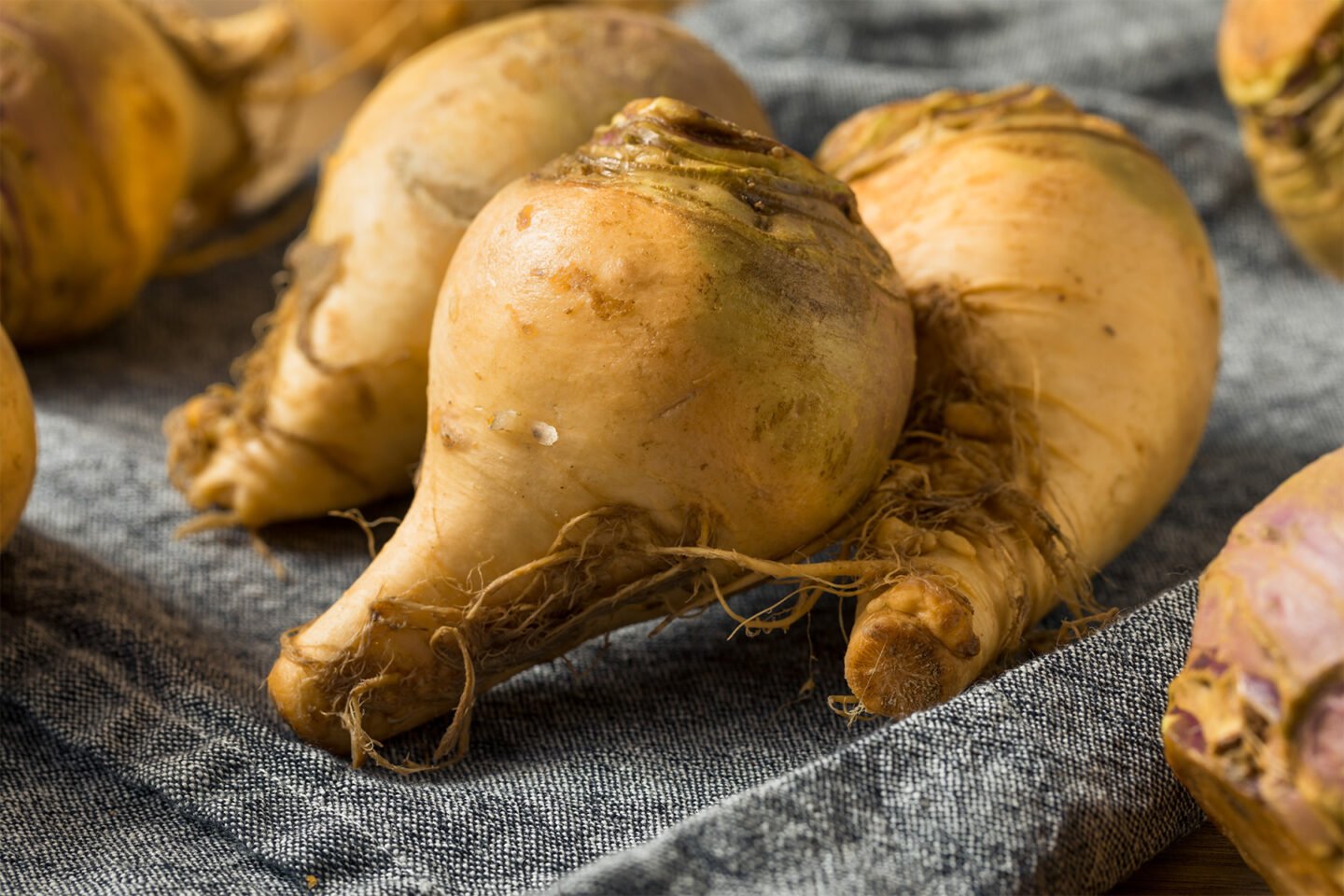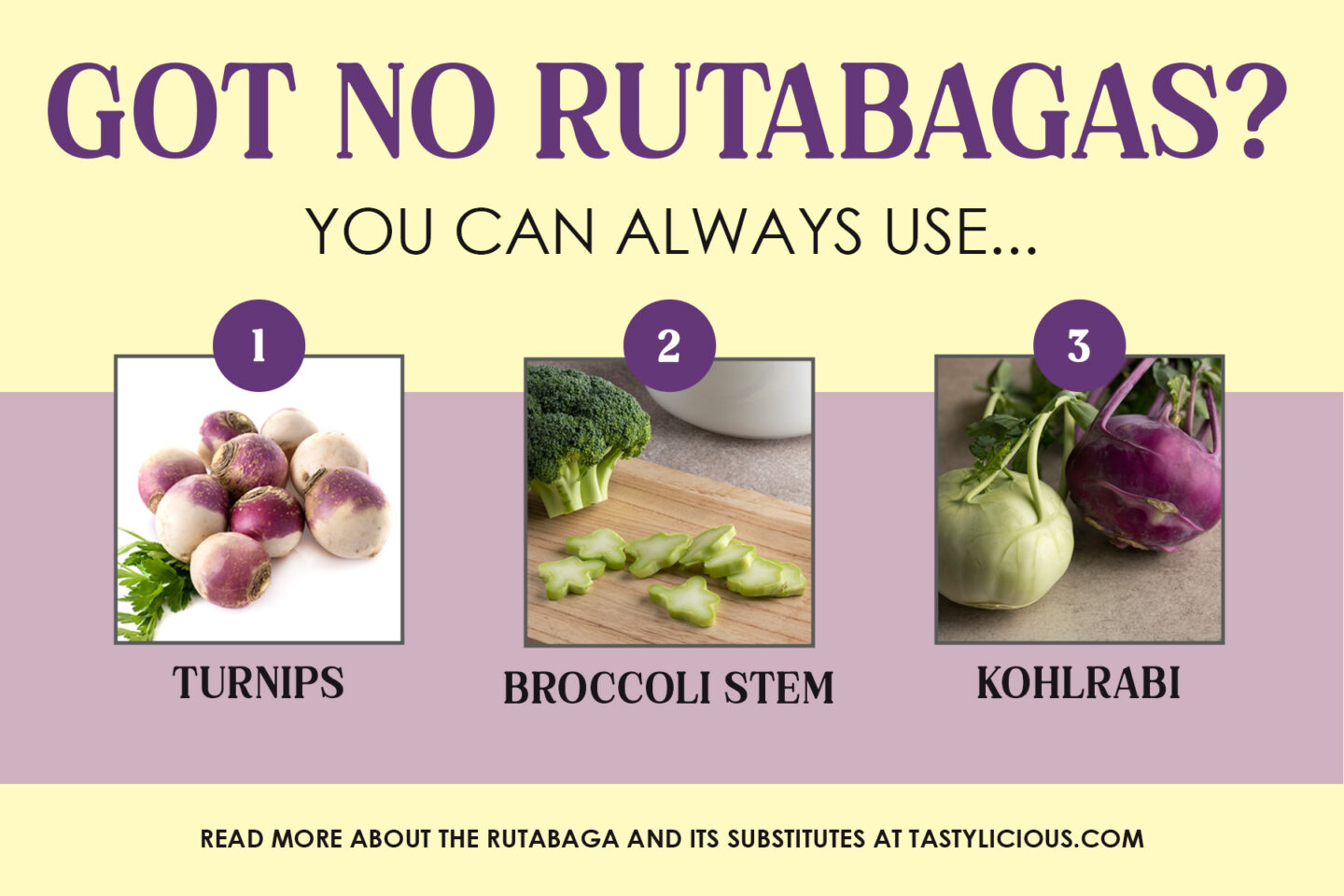Rutabaga, also known as swede, is a root vegetable that is a cross between a cabbage and a turnip. It is mild and bitter, with a slightly sweet undertone. Once cooked, its pungent flavor reduces, although there is still a slight taste of bitterness. In the United States, rutabagas are cooked in stews, casseroles, baked in pasties, and can also be boiled and mashed with carrots or parsnips.

If you don't enjoy the taste of rutabaga or can't find any at your local store, then you're going to need an alternative ingredient. We've compiled a list of excellent rutabaga substitutes so that you can finish that recipe without them. Let's dive in and take a look at your options.
Recommended Substitutes for Rutabaga
1. Turnips
Turnips are a mild and pungent tasting vegetable and are mildly bitter. They make an excellent rutabaga substitute and we'd recommend them at the top of this list. These two vegetables are closely related; in fact, a rutabaga is a cross between a turnip and cabbage. Their bitter, snappy flavor profile and white, firm texture are similar.
Turnips usually don't grow as big as rutabagas and they have a stronger flavor with less sweetness. It is also important to choose a young turnip which hasn't had the chance to mature. The older ones become woody, extra bitter and will overwhelm the other flavors in your dish.
We've previously written an in-depth guide on turnips, so if you'd like to learn more, be sure to check out our article on what turnips taste like here.
2. Broccoli Stems
Broccoli stems probably aren't the first vegetable you think of when trying to replace rutabaga. In fact, most households toss the stem out and only use the florets. However, once cooked, they are a mild, sweet-tasting ingredient, similar to rutabaga.
To use the stems, it is important to cut off the bottom of the stalk, as this section is woody and tough. The skin should be peeled off before cooking, as it is also unpleasant to eat. Use broccoli stems in stir-fries, salads, and frittatas, or even blanch them for a few minutes before dipping them into tzatziki or your favorite dip.
The stems from broccoli will provide a sweeter and milder flavor than rutabaga. As with all the ingredients on this list, use the stems in similar quantities as you would the rutabaga.
3. Kohlrabi
Kohlrabi is a member of the cabbage family and has a sweet and peppery flavor similar to rutabaga. The bulb is the best part of the plant to use when replacing rutabaga. It can be used in soups, casseroles, and salads.
The bulb offers a sweeter, milder flavor when compared to the rutabaga. You can find out more about this lesser-known vegetable by checking out our article on kohlrabi.

4. Daikon
Daikon is a slightly sweet, mild vegetable that has a lovely, crisp texture. Its neutral flavor means it fits in well with many dishes, including salads, stir-fries, and curries. In Japan, daikons are used as a palate cleanser and are also served shredded with sushi. When compared to rutabaga, you'll find that daikon has a slightly more peppery taste.
If you'd like to learn more about this vegetable, then check out our article on daikon radish substitutes.
5. Black radishes
Are you looking for a rutabaga substitute because you don't enjoy their taste? Then why not try a black radish? This vegetable can be used in most recipes that call for rutabaga, but it packs a more powerful flavor punch, which is spicy and hot. Its flesh is white and crispy with a hot spicy bite and the skin is particularly pungent.
The black radish can be eaten raw in salads or cooked and added to stews, casseroles, and soups. The most flavorsome part is the root. If you don't want to let it go to waste, then we recommend sprinkling some salt over it first to pacify its taste.
Fast Facts About Rutabagas
- The rutabaga is also known as Swedish turnip or yellow turnip, and may derive from the Swedish word "Rotabagge," which means root ram, thick root, ram's foot, or baggy root. Source.
- The rutabaga hurl is an annual competition held by the Ithaca Farmer’s Market where competitors toss one of these vegetables as far as they can.
- They can be eaten cooked or raw, but it is best to peel them first.
- During World War II, they were a staple part of many people’s diets and were known to be eaten for breakfast, lunch, and dinner.
- The earliest jack-o'-lanterns were rutabagas, which were hollowed out and then filled with coal to ward off evil spirits.
- One rutabaga offers 107% of an adult’s recommended daily vitamin C requirement and 35% of their required potassium.
- They were first grown in the United States by European immigrants in the 1800’s.
Summing Up
The rutabaga is a mildly bitter root vegetable with a subtle sweetness. If you need a replacement in cooking, then we recommend using turnips for the closest taste and texture. Broccoli stems, kohlrabi, or daikon will also work in a pinch. Black radishes are a good option if you’re looking for a more flavor-packed vegetable that will work in most recipes that you’d use rutabaga in.
What do you think of the rutabagas flavor? Are you looking for a replacement because you can’t find any in-store or you don’t like the taste? Please let us know in the comments below.

Leave a Reply